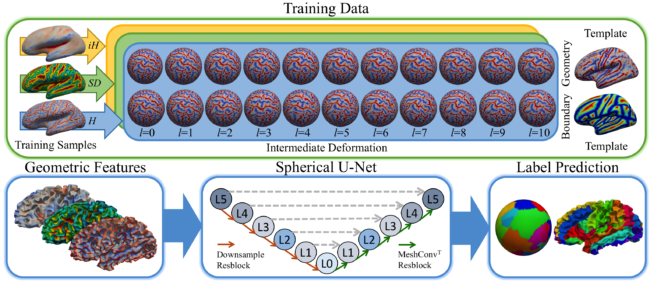Cortical Surface Parcellation using Spherical Convolutional Neural Networks
*Prasanna Parvathaneni, *Shunxing Bao, Vishwesh Nath, David H. Zald, Neil D. Woodward, Daniel O. Claassen, Carissa Cascio, Yuankai Huo, Bennett A. Landman, Ilwoo Lyu, “Cortical Surface Parcellation using Spherical Convolutional Neural Networks”, MICCAI 2019, LNCS11766, 501-509.
We present cortical surface parcellation using spherical deep convolutional neural networks. Traditional multi-atlas cortical surface parcellation requires inter-subject surface registration using geometric features with high processing time on a single subject (2-3 hours). Moreover, even optimal surface registration does not necessarily produce optimal cortical parcellation as parcel boundaries are not fully matched to the geometric features. In this context, a choice of training features is important for accurate cortical parcellation. To utilize the networks efficiently, we propose cortical parcellation-specific input data from an irregular and complicated structure of cortical surfaces. To this end, we align ground-truth cortical parcel boundaries and use their resulting deformation fields to generate new pairs of deformed geometric features and parcellation maps. To extend the capability of the networks, we then smoothly morph cortical geometric features and parcellation maps using the intermediate deformation fields. We validate our method on 427 adult brains for 49 labels. The experimental results show that our method outperforms traditional multi-atlas and naive spherical U-Net approaches, while achieving full cortical parcellation in less than a minute.
